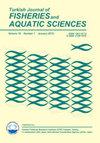Utilization of Fish Scales for Microbe-mediated Gelatin Extraction: A New Biotechnology and Microbiology Avenue
IF 1.7
4区 农林科学
Q3 FISHERIES
引用次数: 0
Abstract
Waste materials are of major concern around the globe. This study aimed to utilize the scales of fish (Labeo rohita) in microbe-mediated gelatin extraction. Three bacterial isolates were isolated from the fish scales and one bacterial isolate FSW3 showing maximum gelatin yield (61.4 %) was subjected to further analysis. The bacterial culture FSW3 (identified as Staphylococcus spp.) with enhanced production of extracted gelatin was set for physiochemical testing, FTIR analysis, UV-Vis spectroscopy, and stereomicroscopic analysis. The extracted gelatin was successfully utilized in various applications including plant growth promotion under salt stress, anti-adhesion films, firmness of yogurt, biodegradable plastic, and anti-microbial food coatings. Results showed that 0.01 mM gelatin promoted plant growth promotion under salt stress. FSW3 extracted gelatin decreased the 2-fold biofilm-forming ability of E. coli, when exposed to the gelatin-based anti-adhesion films coated on a glass slide and polystyrene sheet. The gelatin showed promising findings as anti-microbial food coatings for tomatoes preservation after 21 days and helpful in the firmness of yogurt. Another advantage of gelatin was casting it into biodegradable plastic. The current study provides a promising approach for fish scales microbe-mediated gelatin extraction and uses it to explore new avenues in biotechnology and microbiology.利用鱼鳞提取微生物介导的明胶:一条新的生物技术和微生物学途径
废料是全球关注的主要问题。本研究旨在利用鱼鳞进行微生物介导的明胶提取。从鱼鳞中分离出三个细菌分离株,并对显示最大明胶产量(61.4%)的一个细菌分离物FSW3进行进一步分析。对提取明胶产量增加的细菌培养物FSW3(鉴定为葡萄球菌属)进行理化测试、FTIR分析、UV-Vis光谱和立体显微镜分析。提取的明胶被成功地用于各种应用,包括盐胁迫下的植物生长促进、抗粘附膜、酸奶的硬度、可生物降解塑料和抗微生物食品涂层。结果表明,0.01mM明胶在盐胁迫下促进植物生长。当暴露于涂布在载玻片和聚苯乙烯片上的明胶基抗粘附膜时,FSW3提取的明胶降低了大肠杆菌的2倍生物膜形成能力。明胶作为番茄21天后保存的抗微生物食品涂层显示出有希望的发现,并有助于酸奶的硬度。明胶的另一个优点是将其浇铸成可生物降解的塑料。目前的研究为鱼鳞微生物介导的明胶提取提供了一种很有前途的方法,并将其用于探索生物技术和微生物学的新途径。
本文章由计算机程序翻译,如有差异,请以英文原文为准。
求助全文
约1分钟内获得全文
求助全文
来源期刊

Turkish Journal of Fisheries and Aquatic Sciences
FISHERIES-MARINE & FRESHWATER BIOLOGY
CiteScore
3.10
自引率
0.00%
发文量
43
审稿时长
3 months
期刊介绍:
Turkish Journal of Fisheries and Aquatic Sciences" (TrJFAS) is a refereed academic journal has been published by Central Fisheries Research Institute of Turkey and Japan International Cooperation Agency (JICA), and published in English.
It aims to address research and needs of all working and studying within the many varied areas of fisheries and aquatic sciences.
The Journal publishes English language original research papers, critical review articles, short communications and technical notes on applied or scientific research relevant to freshwater, brackish and marine environments.
TrJFAS was published biannually (April & November) between 2001 and 2009. A great number of manuscripts have been submitted to the journal for review from acceptance of the SCI index. Thereby, the journal has been published quarterly (March, June, September and December) from 2010 to 2017. The journal will be published monthly in 2018.
 求助内容:
求助内容: 应助结果提醒方式:
应助结果提醒方式:


